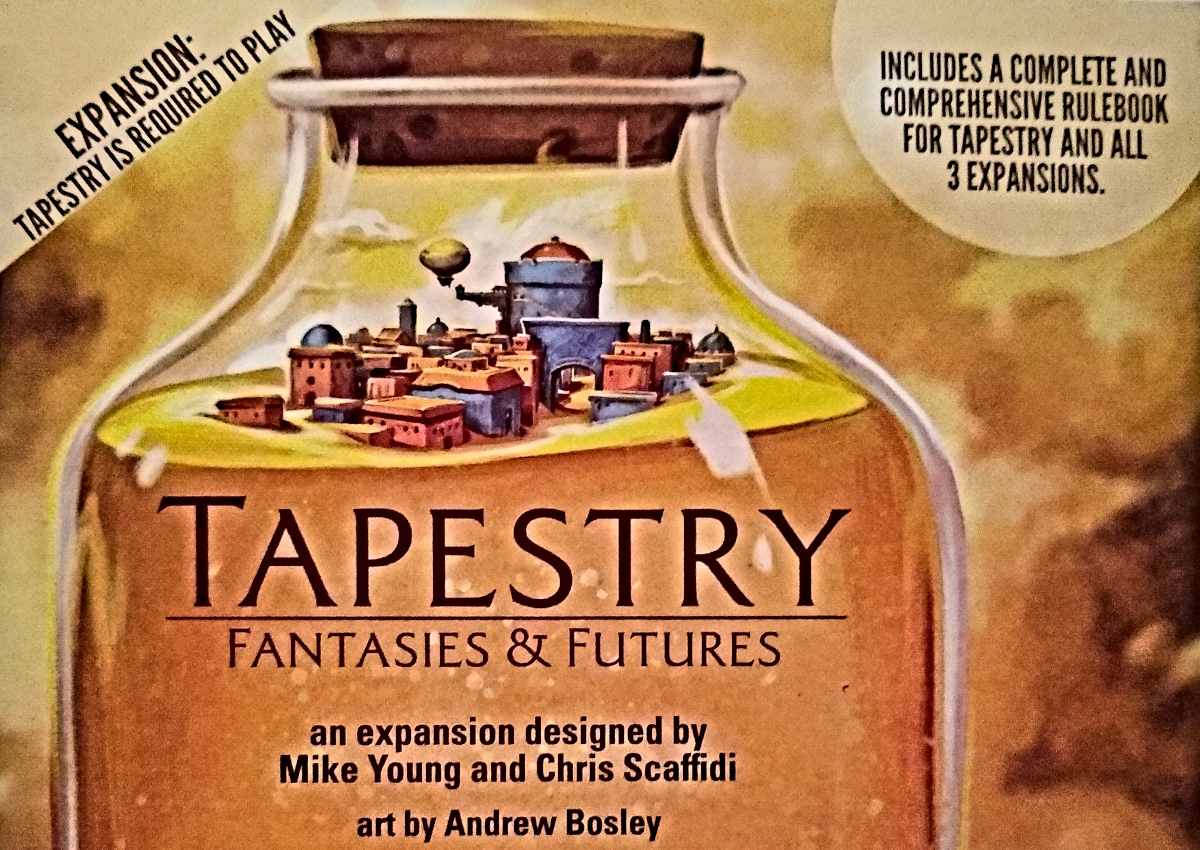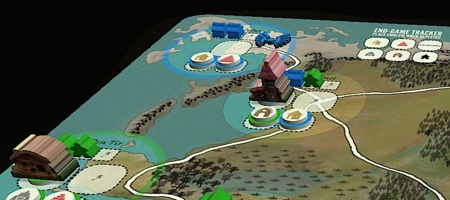In the Fantasies and Futures expansion for Stonemaier’s Tapestry that I designed with Mike Young, you accelerate your civilization’s development by tapping into fantastic new powers provided by parallel universes intersecting our own.
Where did this come from?
Chris’s story
Over the past 3 years that I’ve designed games professionally, Stonemaier and Jamey specifically have had a huge impact on my work. I have learned so much about design from Jamey’s videos, especially the Sunday Sitdowns, and my design philosophy reflects Stonemaier’s emphasis on quick turns, strong theme-mechanism integration, and largely positive player interaction. Stonemaier’s emphasis on high quality components, meticulous development, and eye-catching table presence led me to create this blog on how games can attract attention.
These influences led me to design a game (Emblem) that I initially imagined as a spinoff from Tapestry (as humans came into contact with magic and weefolk). Although Stonemaier opted not to license that game, Jamey appreciated the alignment of our design philosophies and the opportunity to bring thematic elements into a Tapestry expansion. He introduced me to Mike, and after a few months of further discussion and planning, Jamey gave us the contractual greenlight for an expansion.
Mike has been an outstanding partner for this project. He generated many of the initial ideas, including the idea of “links” (below). To complement these ideas, I made a comprehensive list of all the existing components, then checked off the ones that had already interacted with existing civilizations. This process revealed components that hadn’t yet gotten much attention and, after substantial discussion with Mike, generated additional ideas. For example, the idea of having the Illuminati hold all the dice came out of this process. Throughout the development of these and other ideas, Mike has been a great partner who doesn’t tolerate any sloppiness in analysis or testing.
Mike’s story
It was soon after the release of Arts and Architecture, and I was beginning to think about what I could offer for a third expansion, when Jamey contacted me. He had discovered another designer who also enjoyed Tapestry and had some interesting thoughts. Would we consider co-designing the third expansion?
We discussed and found that our interests in game design dovetailed well. Chris is very analytical and cares a great deal about theme. I am very detail oriented and care about finding new mechanics to expand the game. Also, I had the invaluable experience of working on a previous expansion.
We worked together well. And I’m going to be honest here. I had a number of personal issues during the design and development of this expansion which took some of my attention away from the ideas for a lot of cards, civs, and cities. (Things are better now, but from November 2021 until November 2022, it was just one terrible thing after another). I want to make it clear. I had input on everything here, and playtested it all. My fingerprints are there, but Chris really stepped up and created the lion’s share of this expansion. I mean, I worked on this and my input is felt and I am a co-designer, but Chris definitely deserves an MVP award for his work on this expansion.
Thematic premise
Chris was inspired by Stonemaier’s website tagline, “Which world will you visit today?” Jamey has often spoken in his videos of how Tapestry (like other Stonemaier games) allows players to escape for a time from this real world by immersing themselves in something extraordinary. Alternate or speculative timelines is a recurring thematic premise, including in Scythe, Euphoria and Tapestry. From this standpoint, Chris conceptualized each game of Tapestry as a possible historical timeline, or a possible hypothetical universe in which the laws of physics somehow actually do allow players to invent nuclear weapons before the nail. Some of these universes would include strange, immensely powerful or laughable versions of ourselves. Taken together, the set of such games would comprise a multiverse.
If this were so, then what touchpoints could we draw upon from the audience’s prior knowledge of parallel universes? More concretely, how have books and other media drawn upon the possibility of realities somewhere beyond the space-time dimensions of this single universe?
Humanity’s cultural inheritance is rich with answers to those questions. The oldest writings of humanity describe the actions and machinations of beings who transcend this universe. Countless contemporary television shows and movies draw on the idea of other universes beyond our own, often linked into some sort of multiverse. And between those temporal bookends, humanity has literally produced 5400 years of literature and art portraying how the supernatural has visited, intruded upon, blessed and cursed our own universe.
Therefore, the chief challenge that we encountered in this project was integrating concepts from this background with innovative yet thematically appropriate mechanics – and somehow distilling everything into a compact, affordable set of components.
– Charmed: of, or influenced by, a parallel universe –
Tapestry cards
Links and charms: Even before we had started brainstorming for the third expansion, Mike had come up with the idea that he called “links,” which eventually became Tapestry charms as we firmed up the theme.
The original idea was that we could create cards that were strong for the end, but had a right-hand link that was more helpful for the beginning, and vice versa. This would allow the Tapestry cards to be flexible and also would give an interesting decision: play the card now for the charm or wait for the main effect of the card.
It didn’t work out. Playtesters resisted the cards, saying they felt they were never getting the full benefit of the card. We reworked the charms so that they dovetailed with the main effect, both in mechanics and theme, while still attending to the overall balance among Tapestry cards. As a result, the cards became much more popular.
Below are examples of Tapestry cards, with charm on the left and right sides, respectively.
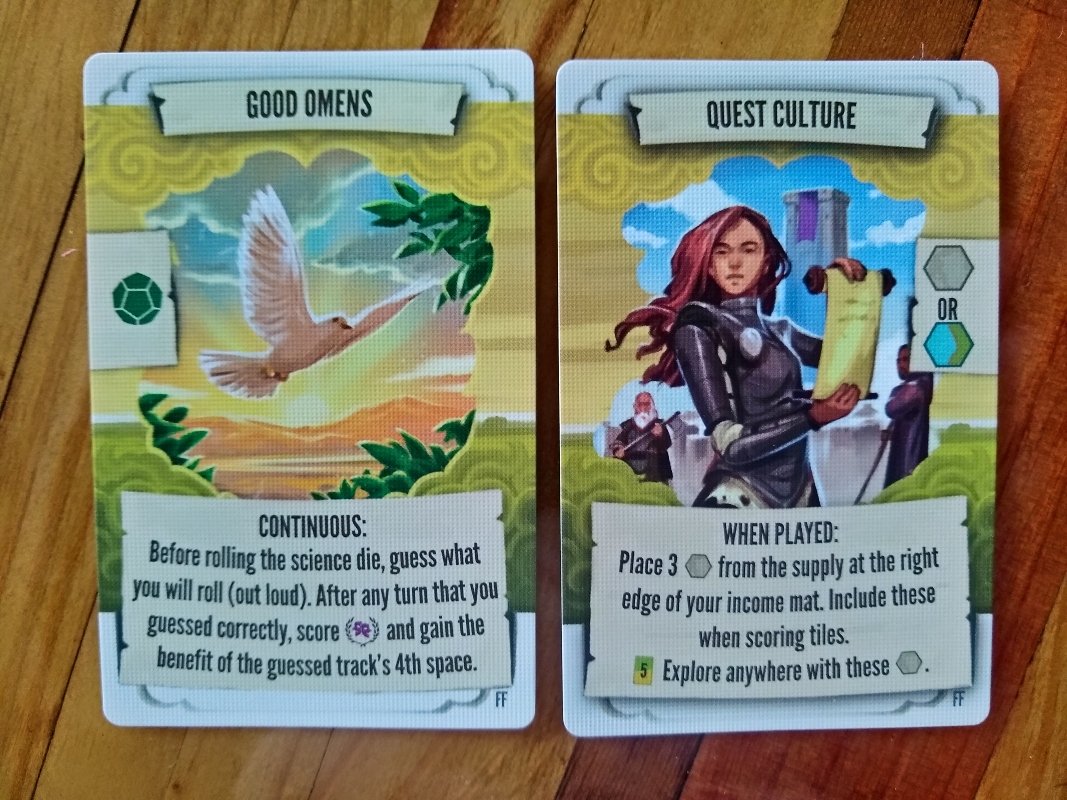
Income turn 5 and beyond: The other extremely early idea was a new type of Tapestry card, Endgame cards. These would be cards that might give something immediately, but the full thrust was that they gave points during the 5th income turn for meeting a certain condition.
These were also not popular. Tapestry is a game of “what can I do now?,” and with endgame cards not giving much of an immediate benefit, they were just not played. I reworked them to the [5] cardmat mechanic, where the Tapestry cards would place something on a special [5] cardmat located between the income mat and the capital city, while still providing an immediate benefit (such as a charm or at least getting to remove an income building from the mat and thereby enhance income). This was way more popular and also solved the question of “what happens if an endgame card gets covered.” As long as there is a thing on the [5] cardmat (i.e. you have scheduled an event to happen in the future during the 5th income turn), then it will happen even if the card that placed the thing on [5] became covered.
Below is a Tapestry card that makes use of the [5] cardmat, as well as a the [5] cardmat itself.
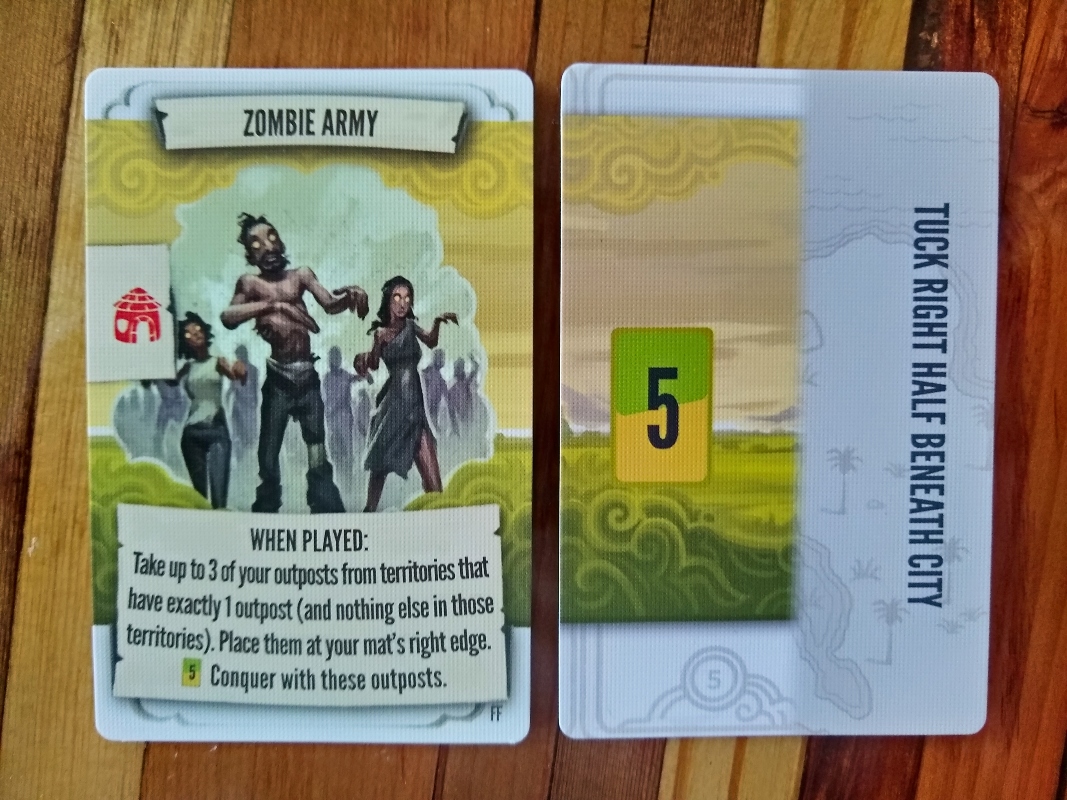
Later, however, we resurrected Mike’s original idea in the core mechanics of two new civs, Merfolk and Elder Ones (to be revealed below). Just because a design idea doesn’t work out in its initial form doesn’t mean it’s a bad one! Sometimes an idea just needs to find the right home.
Some notes on specific cards follow.
Chimera-Citizen Rights and Superpower Regulators: I got to thinking what would happen if we really had extra-dimensional influences messing with our universe. Some of us would become something other than purely human, some sort of AI-human, cyborg, chimera or something that we don’t even have a name to describe. What would the consequences be? Well, as we all know perfectly well from science fiction, these “supers” would probably clamor to be recognized as “real” people, potentially leading to whole new civs, new techs or innovations – and thus was born the effect on the Chimera-Citizen Rights card. And, of course, there would be a backlash. Enter the Superpower Regulators, who inspect other players’ hands for charms that they might want to “borrow.” You can always depend on Uncle Sam to take his cut.
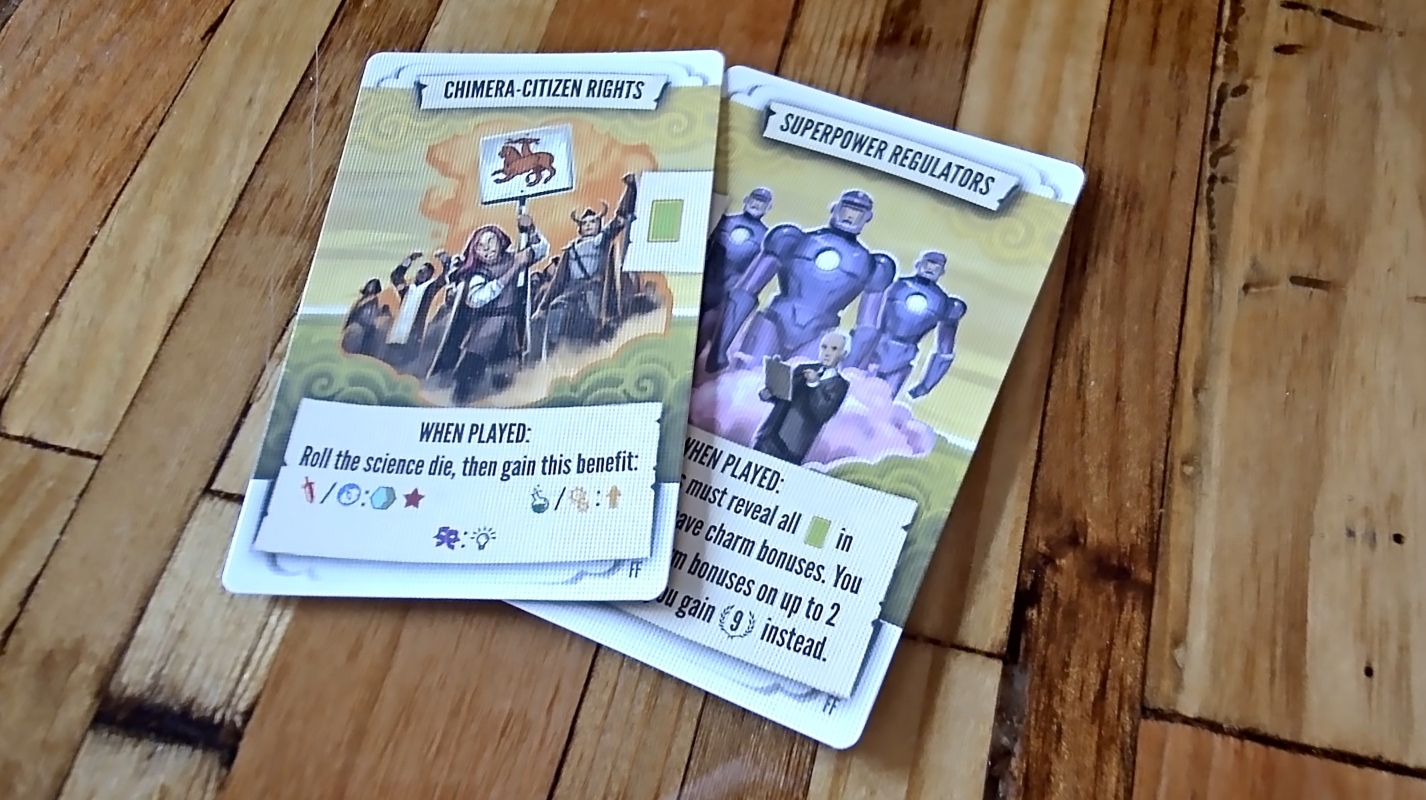
Citadel of Power: We got to complete the trifecta. There already was an expansion Tapestry card that gave its own landmark, and one that stole a landmark from the advancement tracks. Well, now there’s one to give a landmark by digging it out of the tech deck.
Doppelgangers: Jamey started working on the civilization adjustments, and we were giving input, when we learned that some playtesters didn’t care for certain Tapestry cards that we might need to replace. We had experimented with a civ that could have multiple tokens on tracks, but that never panned out. We repurposed the idea to create the Doppelgangers Tapestry card. We’re glad we got the idea to work here!
Ghost Ship: The art for this card is an homage to Mike’s favorite larp, The Final Voyage of the Mary Celeste, which was written by Jim MacDougal and published in 2001 by Mike Young, back when he thought he could make money publishing independent live action roleplaying games.

The Kraken: I pointed out that with our new cards, we really needed more Traps, especially because the second expansion didn’t have any. Statistically speaking, the odds of having a Trap had unintentionally fallen lower, reducing the risk of conquering other players. Mike pointed out that they don’t have to be Traps, but could be new reaction cards. We each came up with a few, including The Kraken. Being able to shout “Release The Kraken!” when someone attacks is so so so satisfying. Sometimes, it’s the little things in life that make it worth living.
Uploaded Consciousness: If a player uploads their civilization’s consciousness, then they don’t need their exploration tiles for the geographical/physical world any more. Here, in exchange, have some transformative insights (Tapestry cards) and a resource.
Zombie Army and Phantasmal Paladins: The nice thing about zombies and ghosts is that they can keep going on forever, even after all the other armies have laid to rest. One playtester quoted his son, “My favorite new tapestry card is the Zombie Army. Please don’t change that one.” Well, it’s one of our favorites, too, not least because of how well the artist, Andrew Bosley, captured the grossness of zombies. Andrew also made phantasmal paladins look so cool that I kind of wish we had them in real life.
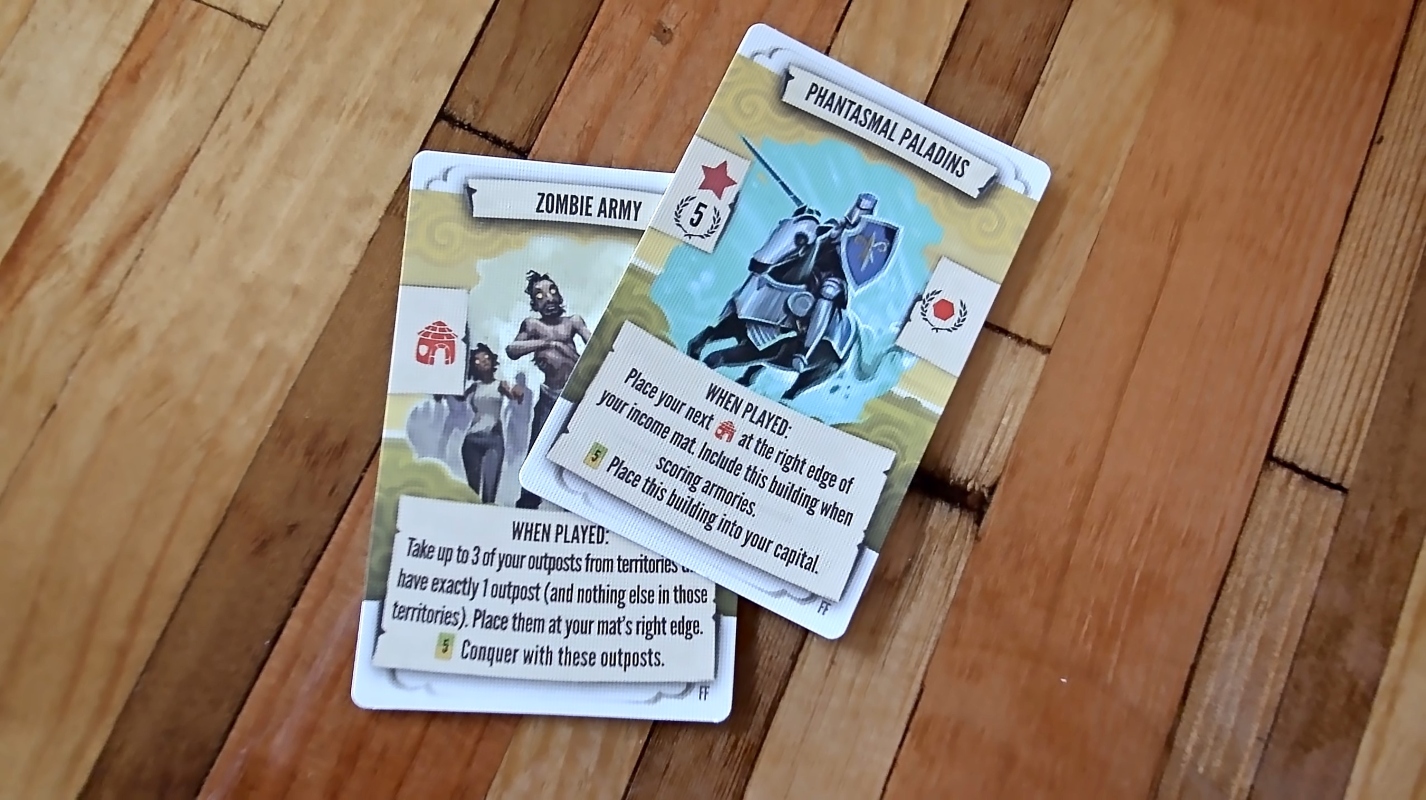
Tech Cards
City-related techs: Our initial idea for tech cards included several in which the square upgrade’s prerequisite was city-based. In particular, these required that the player or a neighbor had already completed rows or columns of the city (see examples below). We opted not to pursue this direction further for a few reasons. First, completing the prerequisite turned out to be more challenging than anticipated in many situations. We mitigated this by providing circle benefits allowing players to place an outpost in the city as a means of covering squares. Second, however, Jamey worried about the possibility of players running out of outposts. Third, we were cognizant of the need to constrain the total number of the cards in the expansion, for affordability; given the issues above, these cards simply didn’t make the cut.
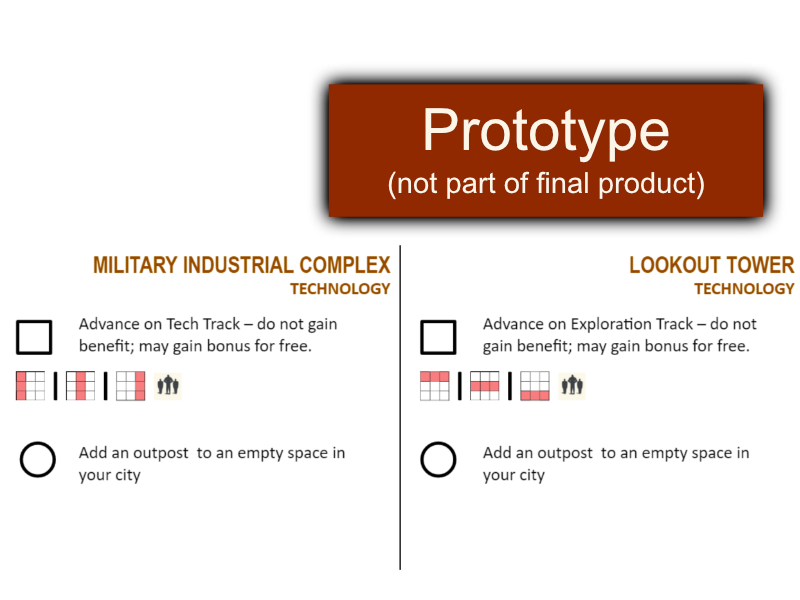
Tech prerequisites related to charm and income 5: We instead channeled our energy in the direction of more tightly integrating the new Tapestry mechanics (charm and big income-turn-5 effects) with the tech cards. Along these lines, I had the idea for tech cards that require charmed cards or income 5 cards. But once that was established, we made sure that as many of the cards for this expansion had charms so they would be useful. I also wanted tech cards with some powerful square abilities, but they turned out to be way too powerful in the hands of really talented players. So Mike suggested making them single use. Once it’s done, flip the card over and there just is no square benefit to gain any more. But it still counts as a tech card for scoring.
Civs
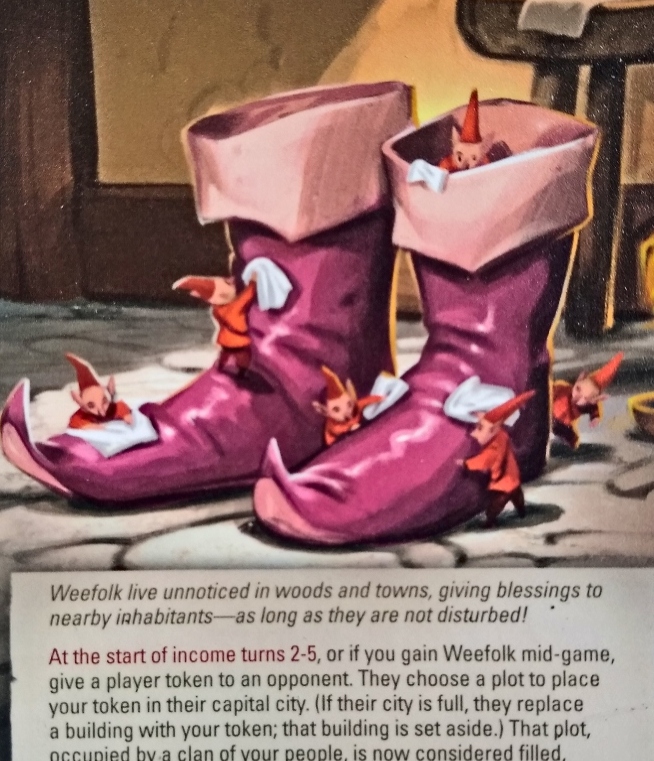
We had brainstormed a lot of ideas about civilizations, and then Jamey told us that we could have 10 of them. Here are several of our favorites…
Weefolk and Faefolk: Fervent Workshop focuses on games about weefolk (e.g., gnomes, pixies and goblins), so it was important from a brand standpoint to include at least 1 or 2 related civilizations in the game.
Folklore says the weefolk of many varieties secretly live in quiet spots among humans, such as in barns or woods, and they come out to help humans as long as they’re treated nicely. We reflected this in the game by letting the Weefolk place tokens on other players’ boards, achieving a mutual benefit.
Folklore says the Faefolk–aka fairies–travel between some other “abode” and our normal universe. We reflected this in the game by letting the Faefolk cycle among different benefits, depending on how they manipulate their civilization’s development (in terms of Tapestry card count).
We were super excited to see Andrew Bosley’s art for these and other civilizations. I consider the Faefolk illustration to be absolutely breathtaking. The striking use of a purple, which connotes magic and supernatural mystery to some people, seemed extremely well-chosen for these two civilizations. Andrew’s art has inspired me in many ways, and I hope in a million years that to be half the artist who Andrew already has become.

Celestials: This civ grew out of an earlier concept that leaned more into Steampunk than sci-fi/fantasy. Below are an early pre-playtest prototype and a late version that includes Andrew’s artwork. In addition to tweaking the theme, we refined the civ’s core mechanism (moving a token representing the capital) to clarify and balance the thematic and mechanical effects.
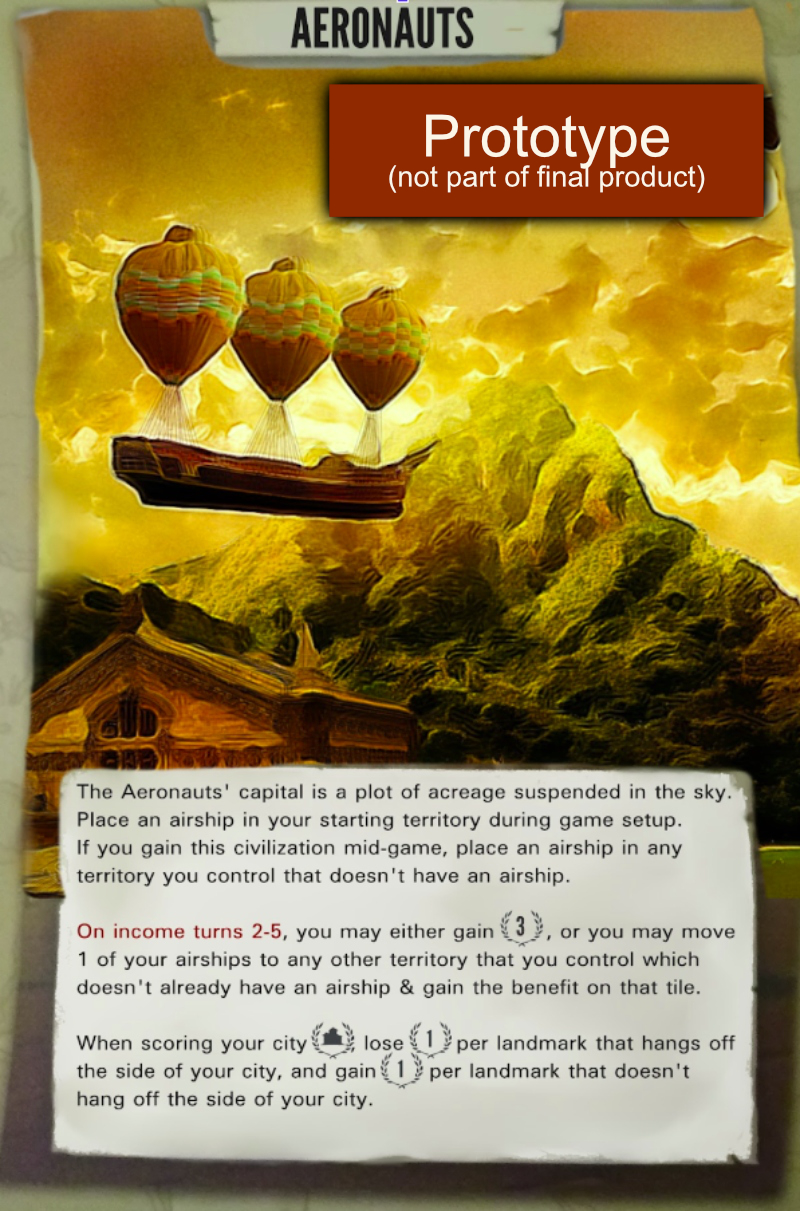
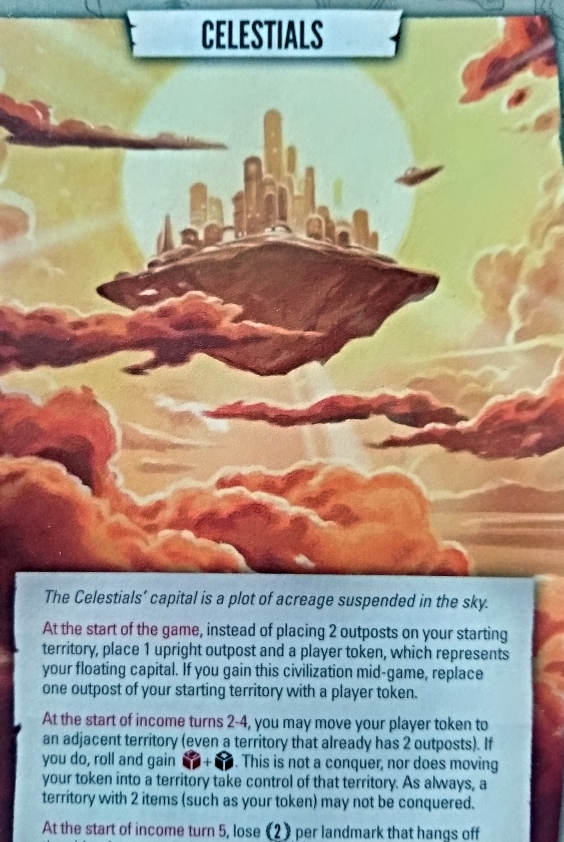
Illuminati: Speaking of steampunk, we also had a civilization that we called the Steampunks, who controlled the dice. Mechanically, these grew out of the review of existing components mentioned earlier in these design notes, with various changes to improve balance and playability. Thematically, we generalized these into the Illuminati to better align with existing tropes that players are likely to already have in mind.
Representationally, I did a close review of how Stonemaier rendered existing game components–something that he often does for his blog–and tweaked how we explained the civilization on the card. For example, these tweaks include turning the two-line flavor text into a single line, explaining corner cases in separate paragraphs, and adding visual frames atop the illustration to show the player where to store the dice. The images below show the evolution of this civ.
(Pre-playtest prototype of the Steampunks shown here, and final version of the Illuminati below.)
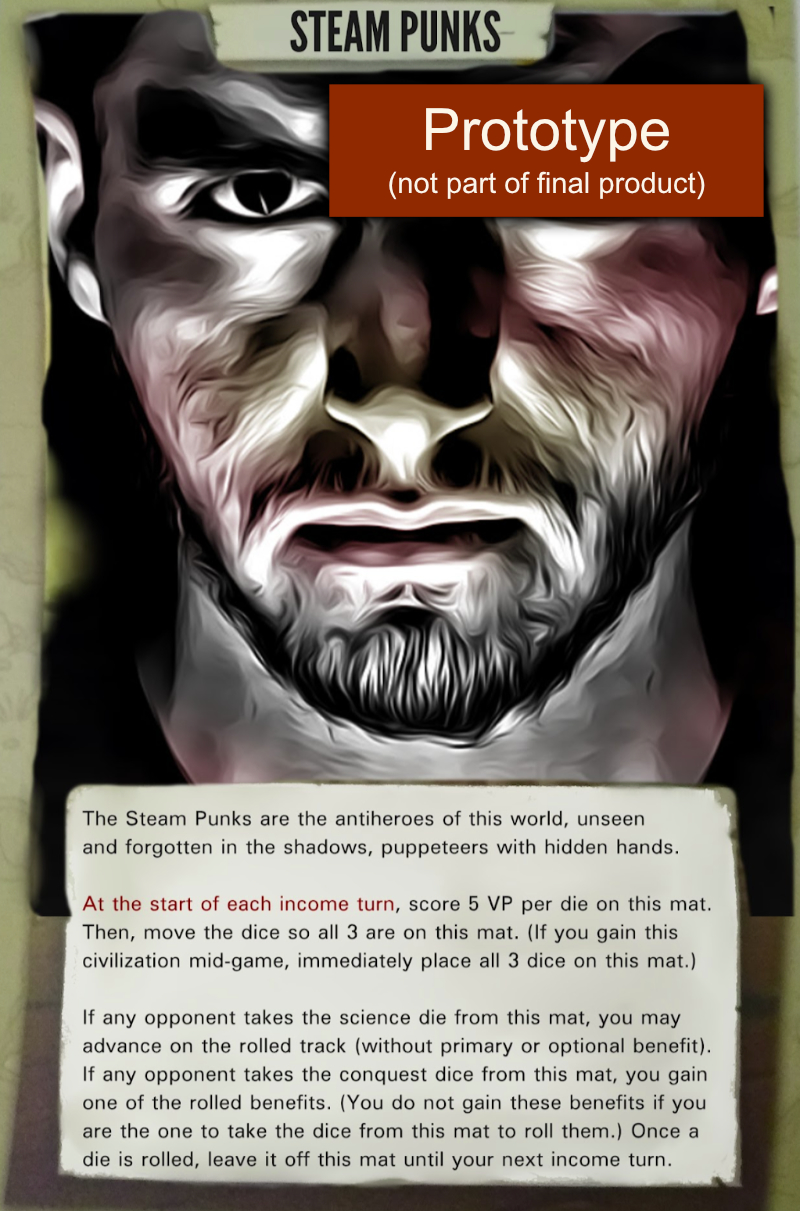
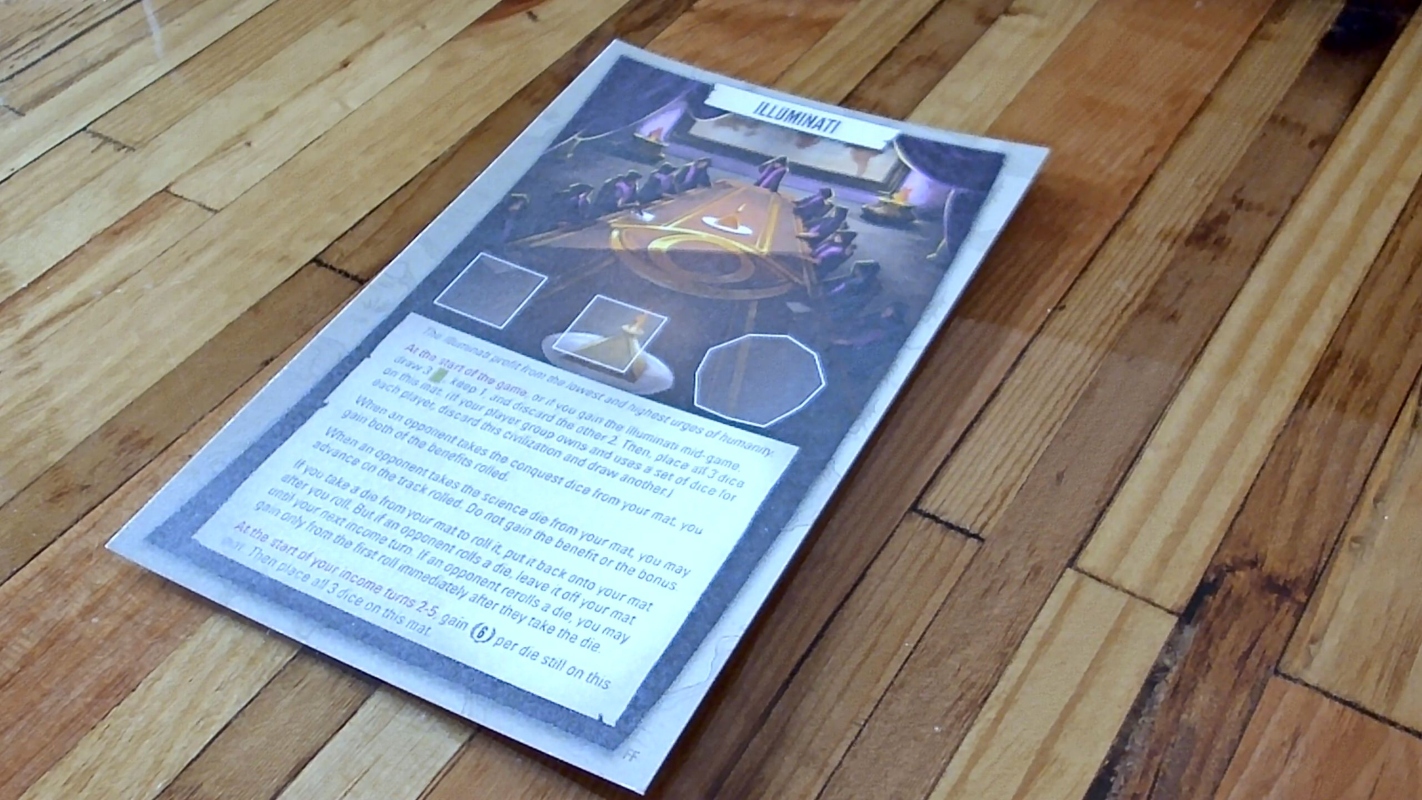
Merfolk and Elder Ones: These civs get to keep playing after Income Turn 5–which is a really different experience compared to the usual play style. The reason is that there’s no Income Turn 6, and thus minimal opportunity to score from the city. Instead, after Income Turn 5, the player is mainly scavenging points from the board. Planning well can generate huge numbers of points, but planning poorly leads to paltry post-Income-5 points.
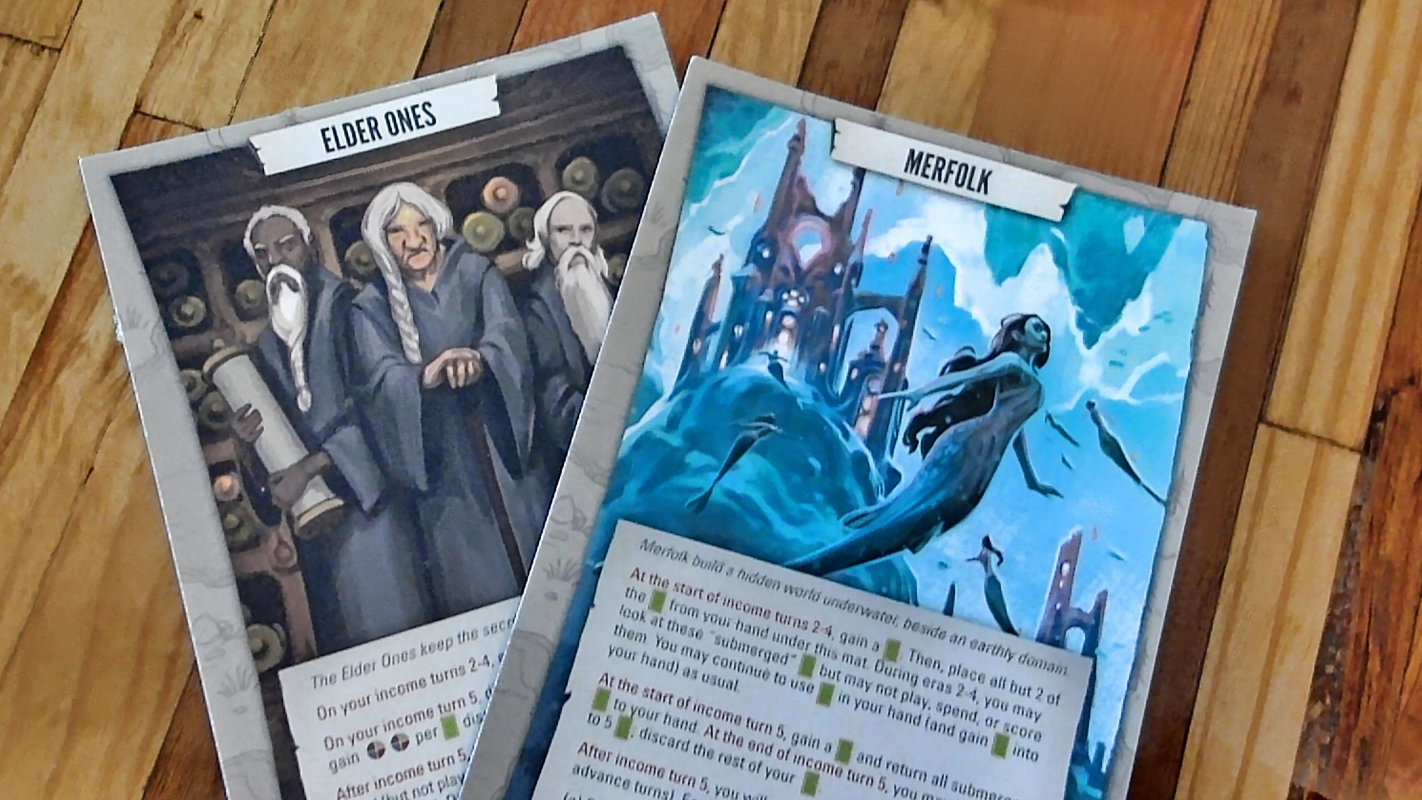
The well of charm runs deep: We still have a bunch of crazy civ ideas. I had an idea for a civilization that could use tapestry cards as upgradeable tech cards, as well as a civ that could dig through the earth to pop up and “squat” to gain resources from other areas of the map (similar to Celestials, but more disruptively).
In parallel, Mike had one that let the player put extra cubes on tracks, and one where the player totally ignores the income tracks and instead uses the ones on the civ mat. Maybe someday Mike will release them in a fan expansion. Seems a fitting bookend to his Tapestry adventure!
Cities
We were overjoyed to include more capital cities. We liked the idea of cities that might gain their resources in different ways, or were even a step beyond the Arts & Architecture cities.
I adopted a user-centered design philosophy while working as a software engineer, so he took delight in creating extremely early mockups of the cities that players could use from our very first directed playtests. These mockups evolved into prototypes that proved useful for communicating with the graphic designer about each city’s most crucial visual elements. For example, the little marsh symbols beside the Will-o-Wisps on Quagmire evolved out of playtester comments regarding the difficulty of telling which little squares interacted with this mat’s scoring conditions; knowing this enabled us to integrate appropriate iconography into the prototype and then to work with the graphic designer on a representation for the final version. For each city below, we include a screenshot of a prototype that the playtesters saw.
Veil: This city emerged from my desire to directly capture the sense of other universes bordering upon our own. Somewhere on the ride to Hogwarts, mystery intersects with mundane. Somewhere along the Kessel Run, how-you-measure-a-life-worth-living collides with how-you-measure-time-or-space-or-whatever. Somewhere, shimmering in the plains of Phaze, a misty curtain delineates the transition between fantasy and truth (as we know it). This–the vision of something greater than ourselves–is the beating heart of all captivating media. Tapestry, like all Stonemaier games, beckons to us from beyond that boundary, inviting us to cross beyond and to step into the world of possibility. (And when you do so, in just the right way, you’ll find that you can get a lot more than just one resource for completing a district!)
Below is a pre-playtest early prototype (called Fae-Edge) and the final playtest version (Veil).
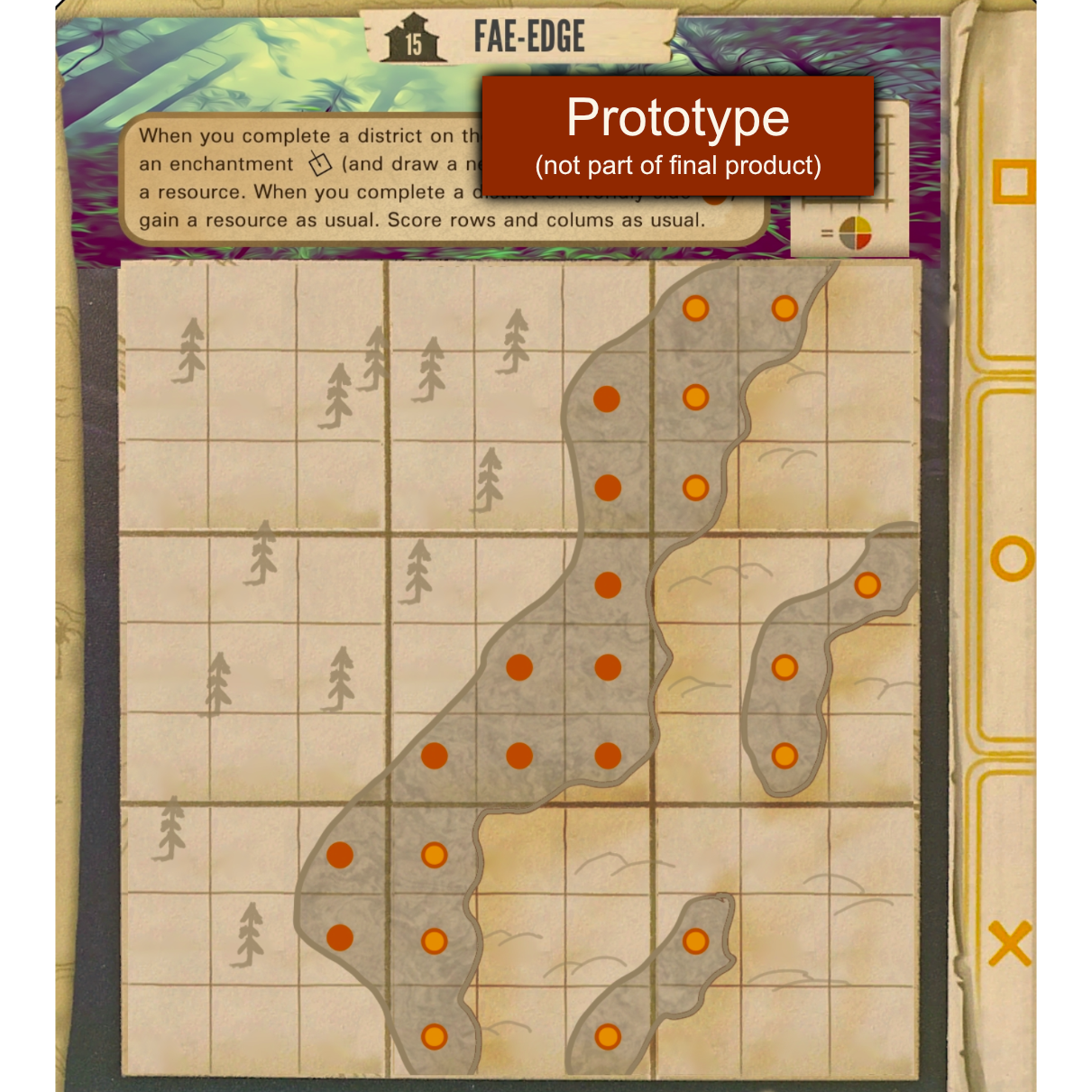

Savanna: Mike provided two cities to test. One was Ares Asteroid Mining Arcology, which didn’t provide resources when the player filled districts. Instead, the player revealed random Tapestry cards during the Income phase based on the number of filled districts, and certain ones would gain income. It was way too luck-based, and it didn’t survive playtesting in that form. With a bit of tweaking for balance, the idea eventually influenced Savanna.
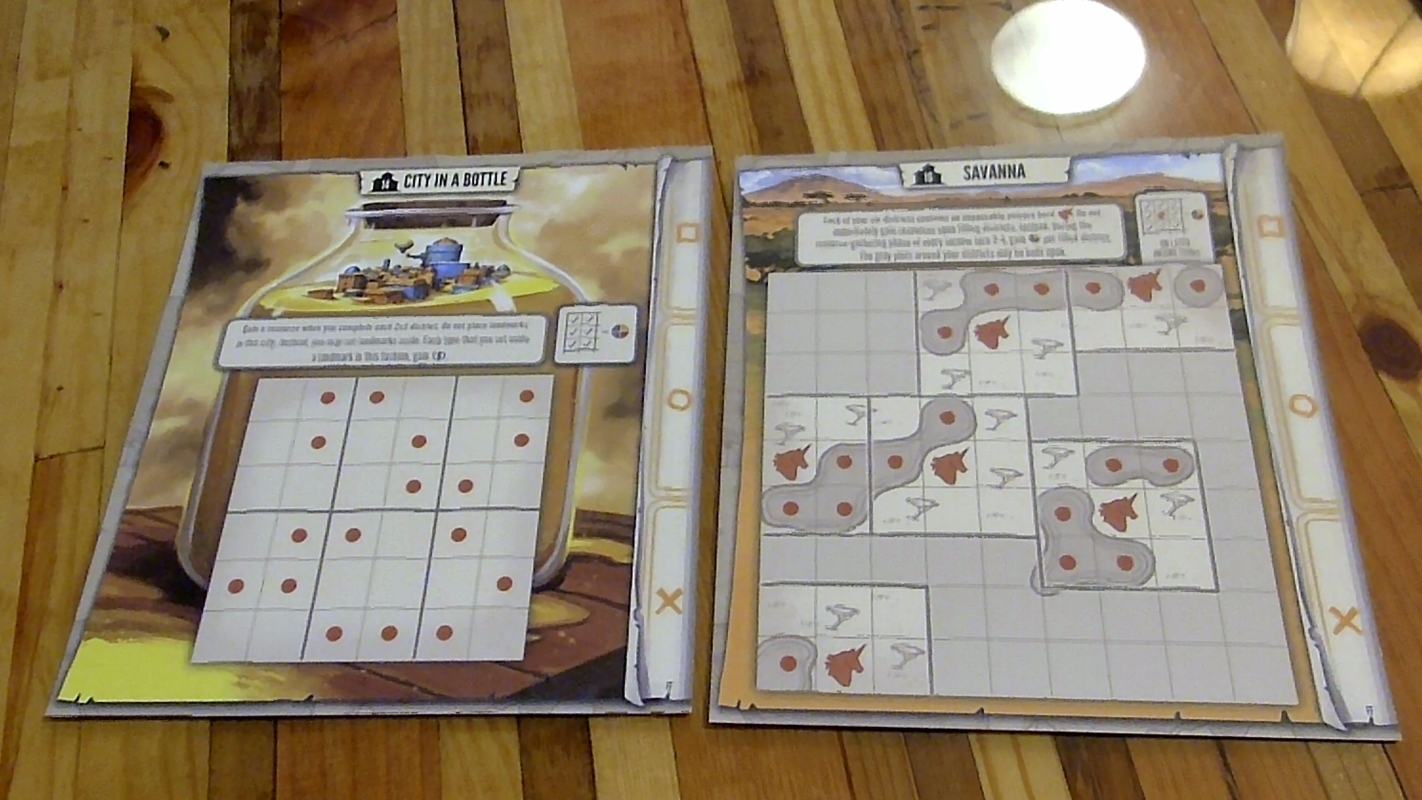
City in a Bottle: Mike really wanted a city that (uniquely) didn’t care about landmarks. In a 4- or 5-player game, landmarks can be tough to come by, especially for the player who plays at the end of turn order without Arts & Architecture in play. Mike wanted a city where it’s fine to happily let others scoop up the landmarks, without any worries about racing up the tracks. Eventually, landmarks did start to matter to the City in a Bottle a little (for balance), but Mike still loves the way it changes game play. Some playtesters have commented on how refreshingly straightforward this city is, for those days when a player just wants to relax for a change.
Netherworld and Polar: I recognized that the word “district” represents an abstraction and, as such, can be tweaked or redefined as needed in an expansion. We took such liberties with Netherworld and Polar, which define districts in terms of paths through the city, rather than areas within the city. The first two figures below show late playtest versions, while the third figure depicts the earliest pre-playtest version of Netherworld (formerly known as Underland, which was overly complex and hard to read).

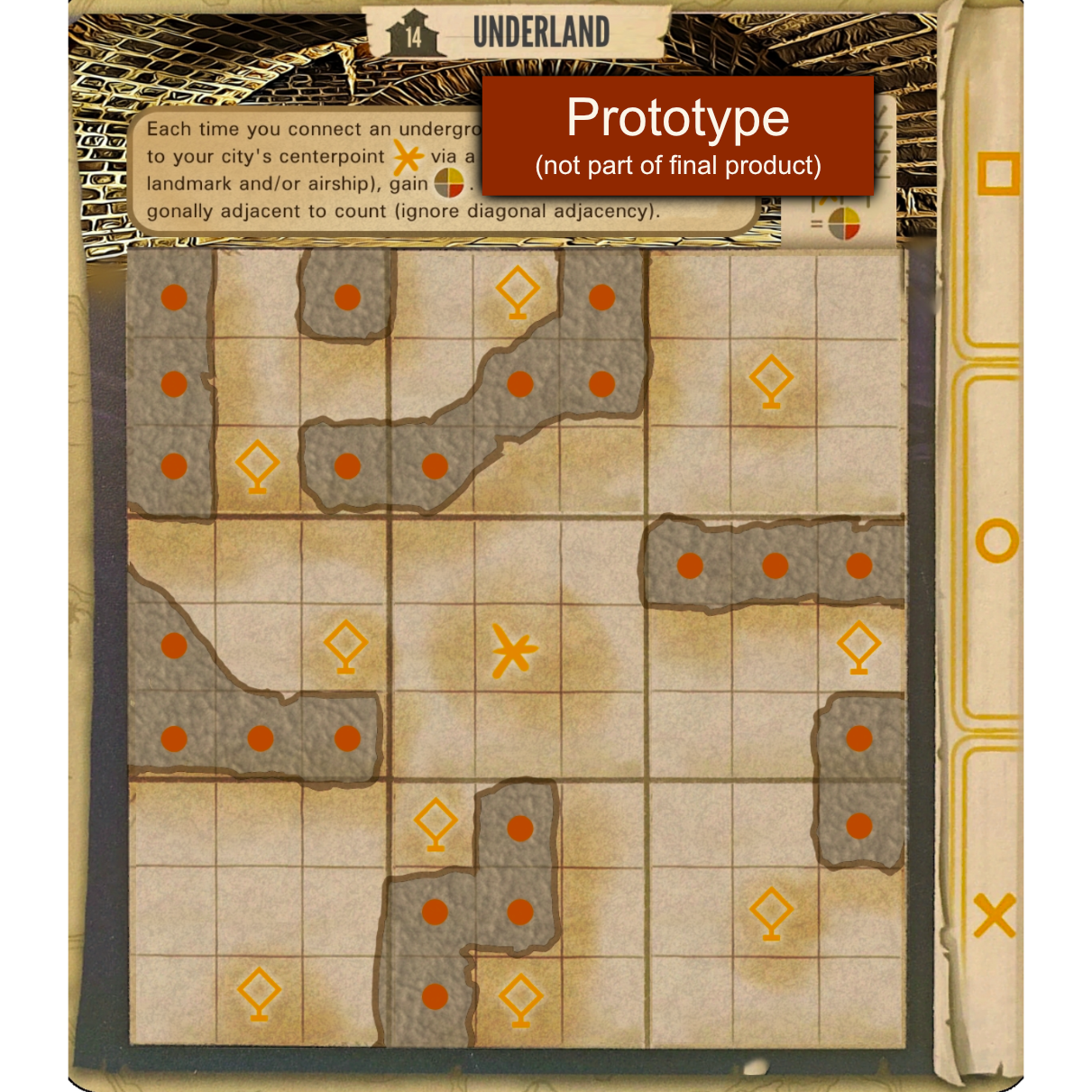
Quagmire: I explored the possibility of districts that changed shape during the course of the game. The city mat rewarded players for placing buildings in such a way that they did not become covered or lost due to changes in the underlying landscape. This mechanism proved too fiddly. In response, we decomposed the specific incentives and constraints that the moving landscape posed to players, and we froze these incentives into a simpler map that now remains static. Further playtesting and refinement led to the Quagmire included in the expansion.
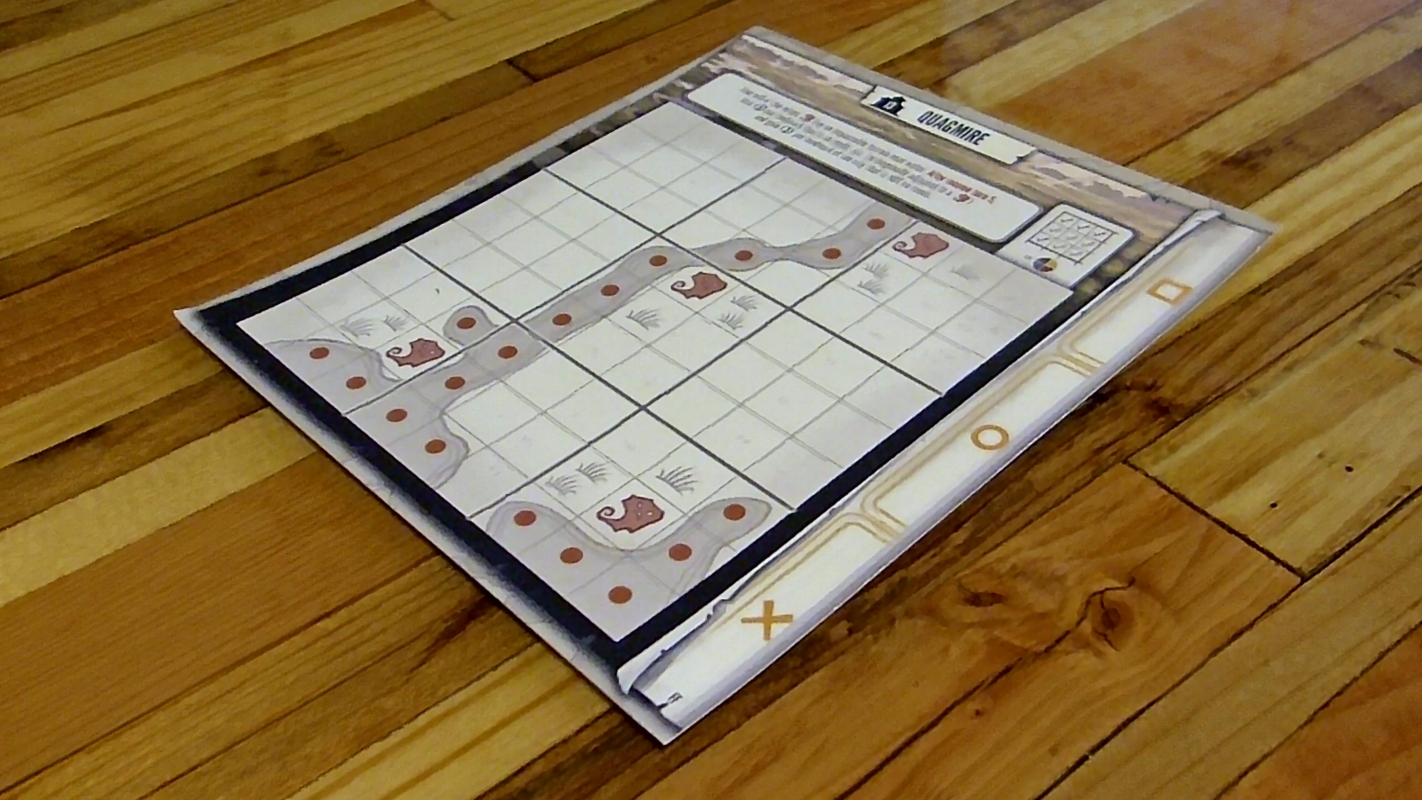
Integrated rulebook
One playtester suggested a consolidated rulebook, which Jamey agreed would greatly improve the playability of the game. He asked me to draft this component, providing an opportunity to review all existing rulebooks as well as online FAQs related to Tapestry. This mini-project was a lot of fun, drawing on both writing and visual skills, as well as the puzzle-assembly skills required to fit everything appropriately on the pages.
Thank you
We’d like to end by thanking one another for being excellent co-designers and for stepping up when we each had to step back a little. We also thank Jamey for giving us the opportunity to expand Tapestry once more. And most of all, we thank the playtesters and all Tapestry players more broadly for the enthusiasm and fun that you generate by playing Tapestry. In this game, Stonemaier has created an uplifting, hopeful view of where humanity’s history is headed. We’re grateful to have contributed to this game and the community that surrounds it.
Enjoy!
Chris & Mike
Each month in 2023, I’ll release strategy tips in my monthly Club Gnome newsletter.
